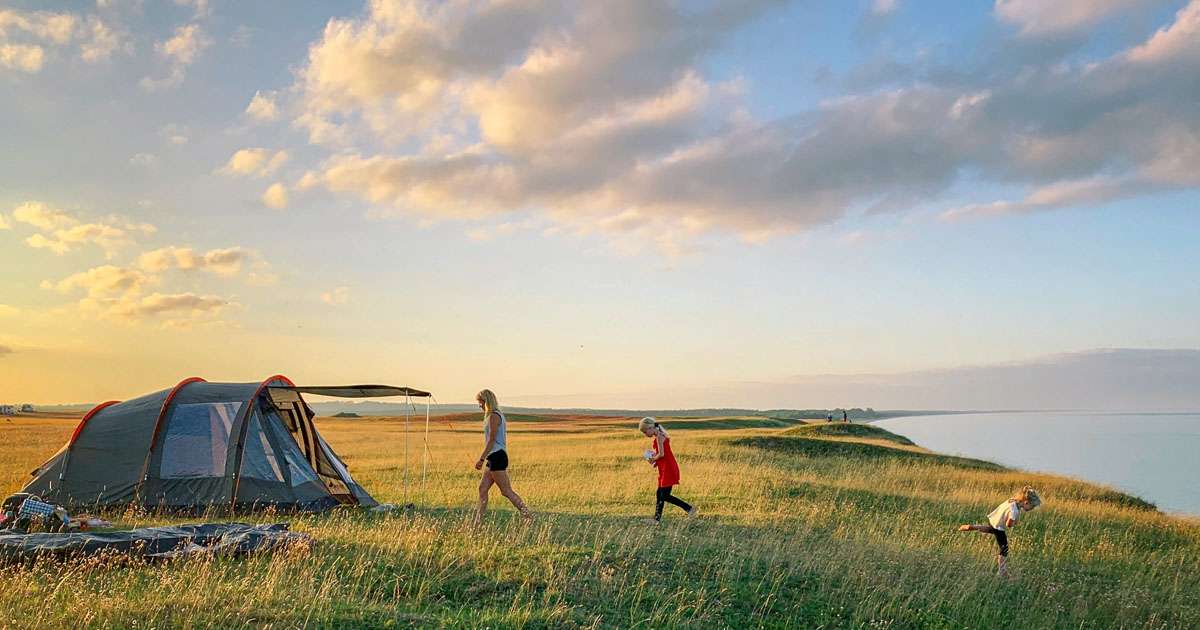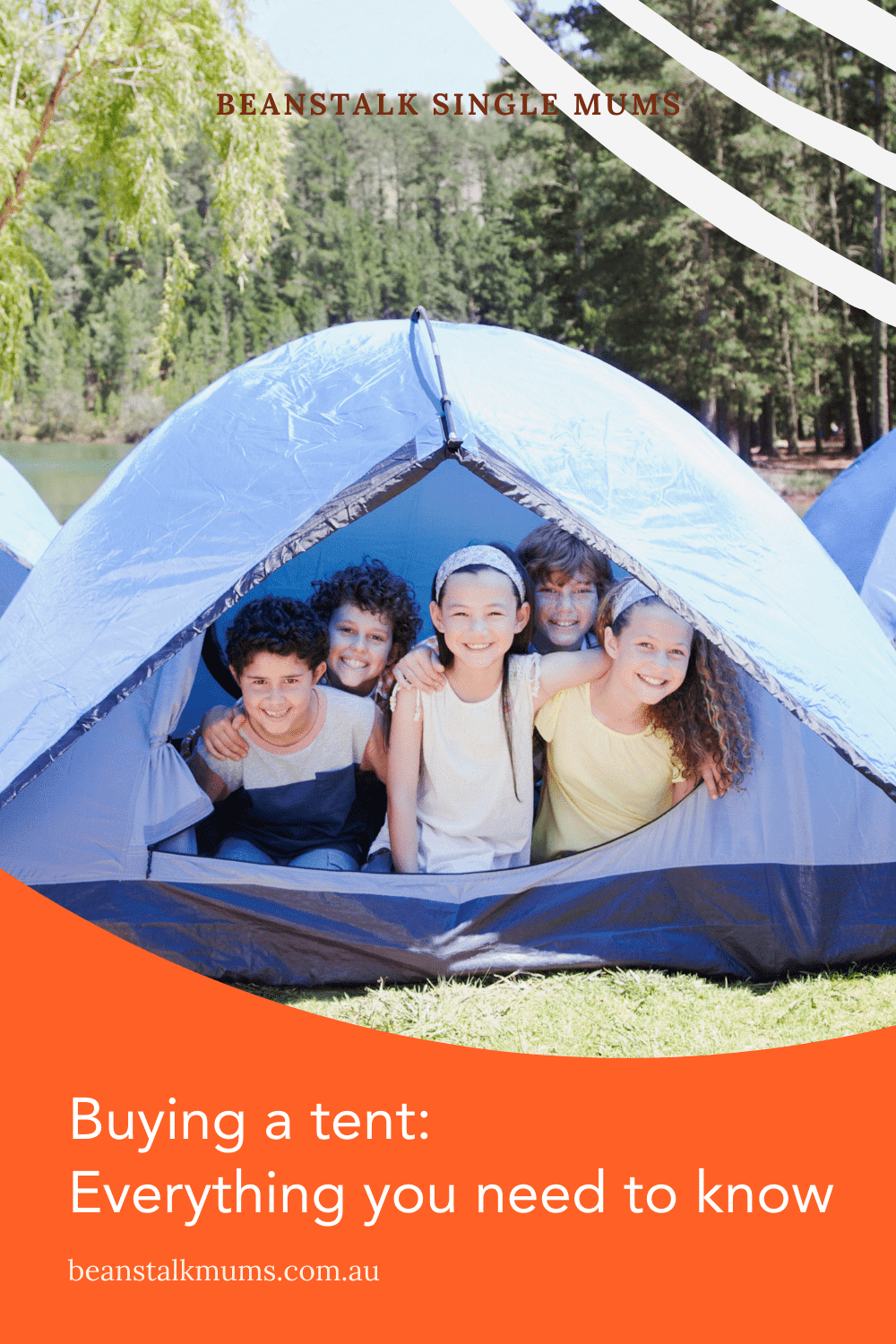
Camping is a great holiday option. Kids love it. It’s reasonably cheap. It gets everyone outdoors. But then there’s the tent …
Having the right tent on your camping trip is crucial. It can make the difference between a holiday success or a holiday disaster.
So, how do you go about buying a tent that you don’t need a degree to put up, and won’t collapse on you in the night?
We have your back in this article where we cover:
- Main points to consider when choosing a tent
- Different types of tents available
- How to tell if a tent is easy to put up (and pack away)
- Tent material and flooring
- Tent vs. expected weather conditions
- “Must have” and handy features
- How to care for your tent so it lasts for years

Further reading: Camping with kids: How to avoid disaster and have a great time.
Main points to consider when choosing a tent
Different types of tents available
- Backpacking. Backpacking tents are lightweight, portable and smaller than other camp tents. These tents can sleep 1-2 people and are best for long-distance hiking.
- Car camping. These tents are heavier and more durable than backpacking tents. As the name implies, they are designed to be transported in cars and pitched beside the vehicle.
- Multi-room and family. If you’re taking the whole fam on a camping trip, get a multi-room tent that can accommodate many people comfortably. Multiple rooms ensure privacy and lots of space for storage.
- Pop-up. Pop-up or instant tents magically pop up into shape without effort–perfect for newbies and camping in fine weather.
- Dome. Dome tents are lightweight, flexible and can sleep from 1 to 8 people. These are easy to set up and comes in single- and double-wall designs.
- Inflatable. An inflatable tent needs an air pump to set up and is heavier than other options.
How to tell if a tent is easy to put up (and pack away)
No one wants to spend the entire day setting up and pitching a tent. Hey, this is supposed to be a vacation.
So, how to tell if a tent is easy to put up?
Before buying, ask the store for a demonstration. You should be able to put up the tent on your own, in the dark, in all weather conditions, without assistance.
If you’re buying a tent online, look for the tent you want on YouTube and watch setup videos.

We found this at: Amazon AU
Tent material and flooring
Tents are usually made from natural (cotton/canvas), synthetic (100% polyester, nylon) or mixed (poly-cotton blend) materials. Cotton tents are breathable and well-ventilated, with a PVC coating for waterproofing. Synthetic tents are very durable and don’t shrink or get heavy when it rains. Polyester tents can also withstand the harsh Australian sun.
As for flooring, you need something durable, especially when camping with kids. When buying a tent, look for leak protection and get a footprint and floor pad. A footprint or floor protector is a special kind of fabric that shields the tent from the ground, and a floor pad levels the surface and provides cushioning. You can use rugs, carpets, blankets and foam for padding. Try a puzzle floor mat for comfortable sleep!
Tent vs. expected weather conditions
When do you usually go camping? Before buying a tent, plan your trip and choose the right tent accordingly. Your options are 2-season, 3-season and 4-season tents.
Two-season tents are good-weather tents that won’t stand up to the slightest wind and rain. These include lightweight summer tents that provide good ventilation but not really ideal for when you’re camping in a gale.
Three-season tents can be used in the spring, summer and autumn, while four-season tents are designed for use in all weather conditions, including heavy snow in the mountains.
“Must have” and handy features
- Rainfly. The rainfly serves as the tent’s umbrella. While tent walls repel water, rainflies are waterproof. You want the biggest rainfly you can get.
- Durable poles. Look for durable aluminium poles that won’t bend or break.
- Double-stitched seams. Folded seams that are double stitched ensure that the tent won’t leak when it rains.
- Noseeum material. Keep the bugs and insects where they belong, outside the tent, with noseeum micro-mesh material.
- Heavy-duty zippers. Heavy-duty zippers are a no-brainer when you’re constantly in and out of your tent.
- Seamless floors. A seamless floor is a leakproof floor. Your tent floor should be a one-piece waterproof material that comes up a few inches to the sides of the wall.
- Roof vents. Roof vents get rid of condensation and help circulate the air at night.
When buying a tent, also consider handy extras on top of your must-haves, like storage pockets, big awnings for protection, more windows for ventilation, and the ability to upgrade the tent (like adding more rooms) if needed.
How to care for your tent so it lasts for years
Regular maintenance goes a long way to ensure your tent lasts for years. After trips, set up your tent and clean with mild soap and warm water. Don’t use the washer or harsh detergents as they can damage the coating and waterproofing.
Clean the poles and zippers with a soft cloth to remove dirt, sand and debris. Finally, rinse your tent and air-dry completely (make sure to check the seams, zippers and small attachments) to prevent mold and mildew.
The tent fabric needs to breathe, so don’t stuff it in a tight bag. A mesh bag or pillowcase in a sealed plastic bin is good for long-term storage. Store your tent in a cool, dry place. You might also want to re-waterproof the tent after multiple uses to extend its life.














